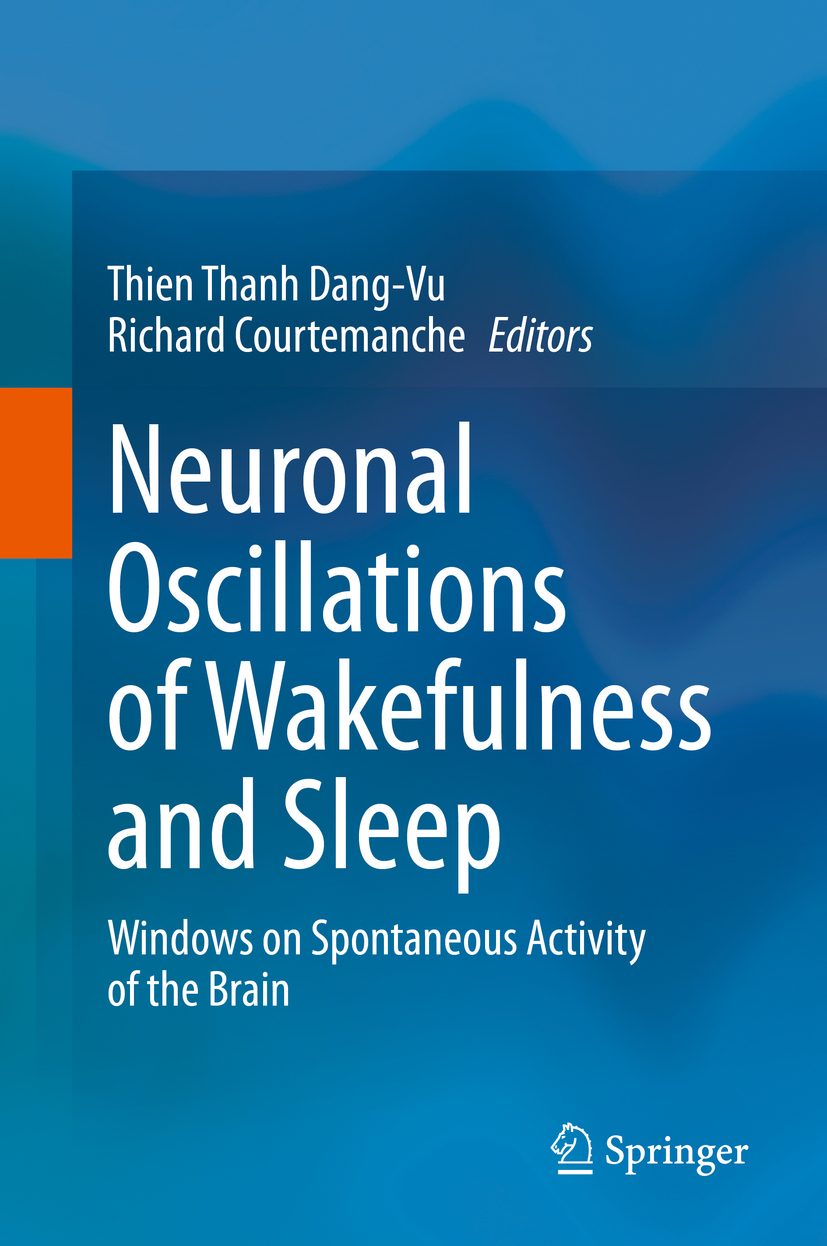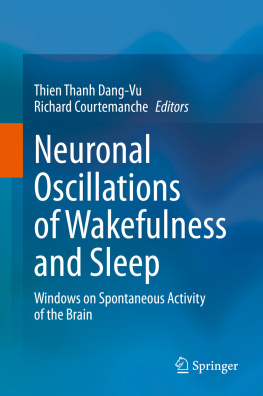Thien Thanh Dang-Vu - Neuronal Oscillations of Wakefulness and Sleep: Windows on Spontaneous Activity of the Brain
Here you can read online Thien Thanh Dang-Vu - Neuronal Oscillations of Wakefulness and Sleep: Windows on Spontaneous Activity of the Brain full text of the book (entire story) in english for free. Download pdf and epub, get meaning, cover and reviews about this ebook. year: 2020, publisher: Springer Nature, genre: Home and family. Description of the work, (preface) as well as reviews are available. Best literature library LitArk.com created for fans of good reading and offers a wide selection of genres:
Romance novel
Science fiction
Adventure
Detective
Science
History
Home and family
Prose
Art
Politics
Computer
Non-fiction
Religion
Business
Children
Humor
Choose a favorite category and find really read worthwhile books. Enjoy immersion in the world of imagination, feel the emotions of the characters or learn something new for yourself, make an fascinating discovery.
- Book:Neuronal Oscillations of Wakefulness and Sleep: Windows on Spontaneous Activity of the Brain
- Author:
- Publisher:Springer Nature
- Genre:
- Year:2020
- Rating:3 / 5
- Favourites:Add to favourites
- Your mark:
- 60
- 1
- 2
- 3
- 4
- 5
Neuronal Oscillations of Wakefulness and Sleep: Windows on Spontaneous Activity of the Brain: summary, description and annotation
We offer to read an annotation, description, summary or preface (depends on what the author of the book "Neuronal Oscillations of Wakefulness and Sleep: Windows on Spontaneous Activity of the Brain" wrote himself). If you haven't found the necessary information about the book — write in the comments, we will try to find it.
Thien Thanh Dang-Vu: author's other books
Who wrote Neuronal Oscillations of Wakefulness and Sleep: Windows on Spontaneous Activity of the Brain? Find out the surname, the name of the author of the book and a list of all author's works by series.
Neuronal Oscillations of Wakefulness and Sleep: Windows on Spontaneous Activity of the Brain — read online for free the complete book (whole text) full work
Below is the text of the book, divided by pages. System saving the place of the last page read, allows you to conveniently read the book "Neuronal Oscillations of Wakefulness and Sleep: Windows on Spontaneous Activity of the Brain" online for free, without having to search again every time where you left off. Put a bookmark, and you can go to the page where you finished reading at any time.
Font size:
Interval:
Bookmark:


This Springer imprint is published by the registered company Springer Science+Business Media, LLC part of Springer Nature.
The registered company address is: 1 New York Plaza, New York, NY 10004, U.S.A.
It is rare indeed that a single volume can intertwine in a delightful and informative set of examples our diverse behavioral modes, from athletics to sleep to epilepsy, with the brain activities that underpin them. The editors and authors have managed to do so. The result is a series of chapters full of ideas, explanations, and hypotheses, all set in a context aimed at readers who have a range of interests: a general interest in the mysteries of the brain and how it could produce behavior and cognition; professional individuals from economists to athletes interested in formalizing these links; academic individuals teaching and learning about how biology can produce behavior; and even philosophers who know that their ideas can be informed by this intertwined approach to brain and behavior.
Sometimes the seemingly esoteric world exemplified by the physicists, engineers, and astronomers who examine oscillatory activities and signal frequenciesand who use the math that goes with these analysesseems too demanding and almost off-putting for non-experts. The editors have gone to great lengths to avoid this potential problem. As a consequence, they have uncovered for the reader an emerging and exciting field in which we know that we do not know how the brain works, but at the same time are discovering signaling mechanisms never before open to deep analysis.
The electrical activity of the brain has been a subject of fascination for scientists since Victorian times. The first human brain recording was made by Hans Berger in 1924, who referred to his recordings as theElektrenkephalogrammor Electroencephalogram (EEG) in English. The literal meaning from the roots of the word is electrical writing of the brain. The assumption that the electrical signals of the brain must, in some way, convey information about mental activity was present from the beginning: Berger was searching for the physical basis of mental telepathy (Millet 2001). Although today it is thought that the electrical output of the brain is much too weak to have any noticeable effect on the nervous systems of other individuals (with the possible exception of certain electric fish), it was not an unreasonable belief at the time, given the sudden ubiquity of radio communications and the absence of scientific research on the existence (or lack thereof) of telepathy. Science fiction writers further explored this theme, notably in the classic Stanislaw Lem novel (1961) and Andrei Tarkovsky film (1972) Solaris, in which an X-ray beam is modulated by a humans EEG in hopes of communicating with an alien intelligence.
One of the most striking results from Bergers 1924 publication was that when the subjects eyes were closed, the occipital contacts showed a 10 Hz oscillation, whichbeing the first brain oscillation observedwas dubbed alpha. Study of changes in the patterns and frequencies of brain oscillations soon proved their utility not only for understanding the structure of sleep, but also for neurological diagnostic purposes. By the end of the 1950s, there was a rich literature available in both of those fields. However, the connection between electrical brain signals and mental activity remained obscure, not least because of the fact that in the conscious waking state and in the altered consciousness state of REM (dreaming) sleep, the oscillations that were so clear in deep sleep broke down, producing a desynchronized, i.e., apparently random, signal. Some researchers despaired of ever understanding any connection that might exist between the observed random electrical activity and the highly structured activity of conscious thought (although occasional anecdotal evidence continued to pique the interest of other observers, e.g., Sacks 1999).
Sensation provides the essential raw material for mental activity, or at least so it can be argued. As early as 1947, electrical brain activity evoked by somatosensory stimulation became amenable to study by means of EEG recording (Dawson 1947) and a large literature on sensory-evoked potentials in all modalities followed. Dawsons original method of showing the typical response to stimulation involved superimposing multiple EEG traces displayed on an oscilloscope following repeated applications of the stimulus, and he immediately pointed out that this method could be greatly improved if the signals could somehow be averaged rather than simply superimposed. There followed a decade of various attempts to realize Dawsons signal averaging concept, and by the early 1960s signal averaging equipment was widely available for research. The concept of stimulus-evoked potentials soon became generalized not only to motor behavior, but even to hypothetical brain states that could be inferred from task conditions, such as the Contingent Negative Variation (Walter et al. 1964) and the Readiness Potential (Kornhuber and Deecke 1965). An entire new field of study of event-related potentials (ERPs) came into being, in which the effects of cognitive factors on gross brain physiology were quantified: the amplitude of the Late Positive Component (or Complex), 450750 ms after stimulus presentation, can predict whether the presented stimulus item is later remembered (Sanquist et al. 1980); the Early Left Anterior Negativity occurs in response to violation of linguistic conventions (Frisch et al. 2004); the Error-Related Negativity occurs after task errors are made (Falkenstein et al. 1991; Gehring et al. 1993); and the mismatch negativity (MMN) occurs in response to an unusual stimulus in a sequence of stimuli (Ntnen et al. 1978).
Font size:
Interval:
Bookmark:
Similar books «Neuronal Oscillations of Wakefulness and Sleep: Windows on Spontaneous Activity of the Brain»
Look at similar books to Neuronal Oscillations of Wakefulness and Sleep: Windows on Spontaneous Activity of the Brain. We have selected literature similar in name and meaning in the hope of providing readers with more options to find new, interesting, not yet read works.
Discussion, reviews of the book Neuronal Oscillations of Wakefulness and Sleep: Windows on Spontaneous Activity of the Brain and just readers' own opinions. Leave your comments, write what you think about the work, its meaning or the main characters. Specify what exactly you liked and what you didn't like, and why you think so.









